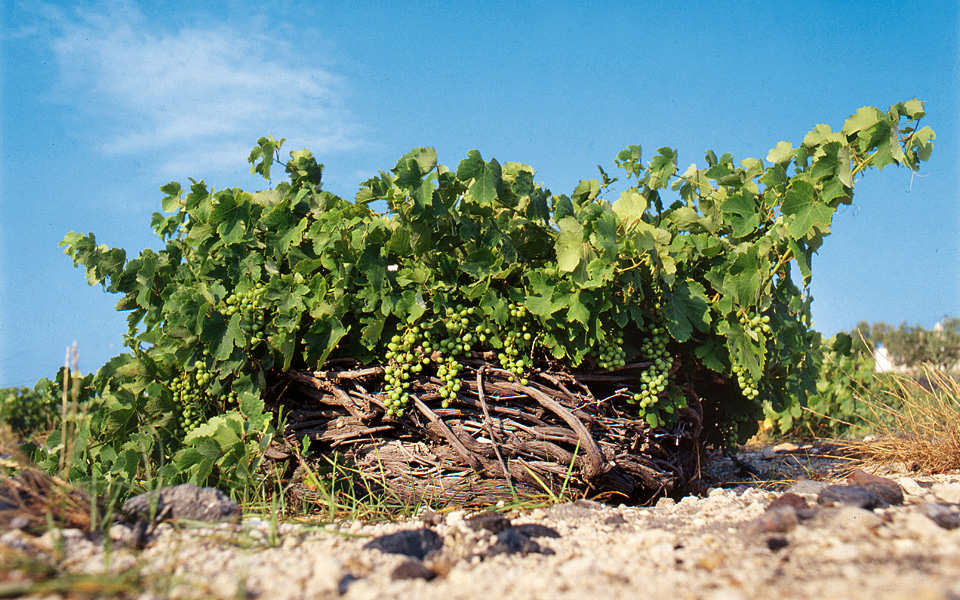Already world-famous for its breathtaking caldera views and sunsets, its architecture, local products and cuisine, amazing hotels and still-beating volcanic heart, Santorini has also built a strong brand name in the international wine market. Its aged vines, some as old as 400, unharmed by phylloxera louse which couldn’t survive in the volcanic soil, trained in the shape of a basket (or kouloura) to protect them from strong winds and preserve precious humidity, produce four classic varieties: the white Assyrtiko, Athiri and Aidani, and the red Mandilaria.
Other than a producer of excellent wines, Santorini is also an exemplary oenotourism destination, with wineries that offer everything from tailor-made experiences to group tours and tastings.
To tell its tale, we have selected excerpts from the preeminent book on the island’s wine, Santorini: An Historical Wineland, by Stavroula Kourakou-Dragona*.
Other than a producer of excellent wines, Santorini is also an exemplary oenotourism destination, with wineries that offer everything from tailor-made experiences to group tours and tastings.
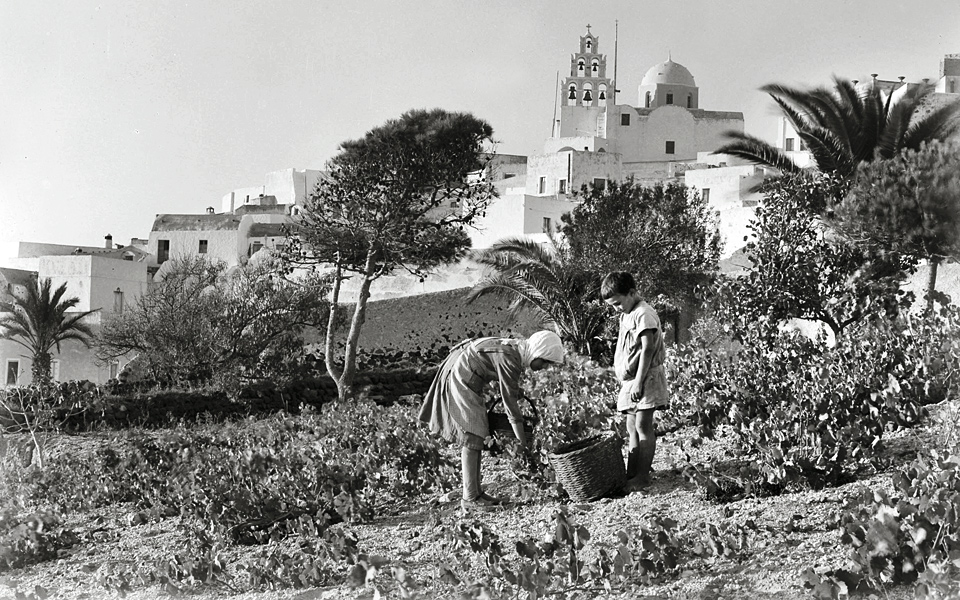
© Benaki Museum / Photo Archive
“I advise all who visit Santorini to go up Profitis Ilias mountain, particularly in the season when the vines are verdant, in order to enjoy this unique spectacle that delights the eyes and the soul,” wrote Abbe Pegues, prior of the Lazarist monastery in Santorini, who lived on the island for many years in the early nineteenth century. And he continued: “From the peak of this mountain in the south of Santorini, which is the island’s highest point, one’s gaze falls enchanted over a seemingly enormous expanse of vines, covering almost the entire isle, and roams over three delightful plains, bounded by smooth hillsides or blocked by steep mountains, half cultivated, half fallow … In summer they compose a splendid picture, as the green of the vines creates a pleasing contrast with the yellow of the scattered fields of ripened grain … Santorini offers an astonishing array of contrasts: there are the mountains, volcanic and rugged, half arable and half fiery rocks, some beautiful and others terrible; there are the deep ravines that break up the plains and the fertile slopes, those densely planted with vines; there is the proximity of the sea, which embraces the island from every side, as if it were a huge plain … This, after so many major disasters, is the enthralling spectacle offered by the remnants of mutilated ancient Kalliste. From these we can easily imagine how beautiful the island was as a single whole, before the disasters that shattered it and rent it apart from all sides.”
The disasters Abbe Pegues mentioned were caused by the volcanic eruption around 1630 BC that buried the thriving prehistoric city of Akrotiri and created the caldera. In this prehistoric phase of the island, there are many indications of vine-growing and winemaking. As we learn from Christos Doumas, excavator of Akrotiri, “not only have pieces of charcoal from vine wood been found in the excavations at Akrotiri, but also grape pips, dispersed among the ruins of the settlement. Moreover, bunches of grapes feature as decorative motifs in the vase-painting of the period. Evidence of winemaking and wine trading are certain kinds of storage jars (pithoi) with a spigot near the base of their narrow base.
Some three centuries after this tremendous disaster, the island was resettled. Wherever the new inhabitants came from, they had to survive on a treeless, waterless and wind-swept island with very little rainfall and hard compact soil that, when it was dug, became like sand, and was whipped up in swirls by the winds, as in the desert. In all eras, the islanders of Santorini have learned to live with nature, which has forced them to find solutions in order to cope with their needs, and to respond to it in a unique way, because the conditions they had to deal with were unique. So, they cultivated those plants that could survive in the island’s arid and hot conditions, including, of course, vines. They arranged whole hillsides in stepped terraces, building dry-stone walls with black-lava cobbles, which in summertime are crowned with the green shoots of the vine and keep warm their juicy fruits. A combination of volcanic gloom and Dionysiac hope; the polar opposites of an island unique in the world.
“…not only have pieces of charcoal from vine wood been found in the excavations at Akrotiri, but also grape pips, dispersed among the ruins of the settlement.”
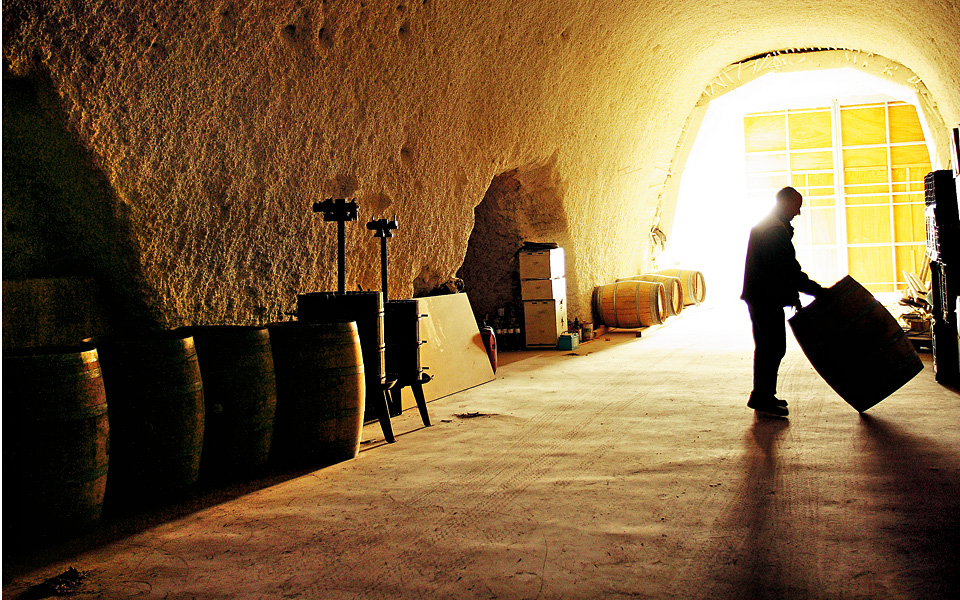
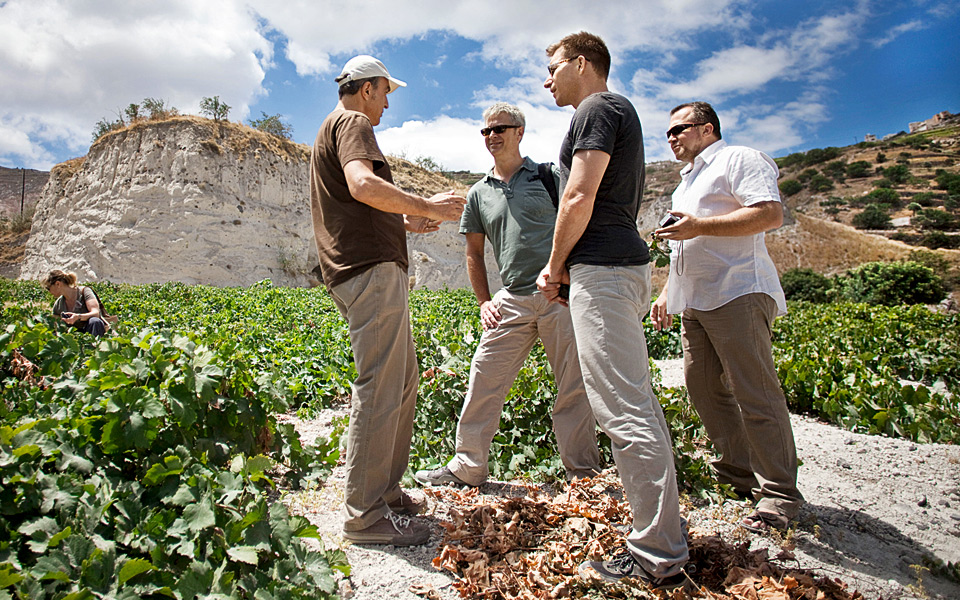
© New Wines of Greece
A vineyard uninfected by phylloxera
In the Santorini ecosystem, no extraneous agent intervenes between plant and soil, as it the case in regions blighted by phylloxera, where the vineyards were destroyed by this pest and were replanted with resistant American rootstock grafted with local cultivars. As the Santorini vineyard is uninfected, the local vines sink their roots directly into the island’s soil, which enables the renewal of the old vines with layings or cuttings, just as was done in antiquity. So the vineyard of Santorini is one of the very few traditional vineyards with such credentials.
The fact that phylloxera vastatrix did not appear on Santorini is due to the protective role of the island’s soils in defending the plants it hosts. Sandy soils prevent the development of the phylloxera insect and the soils of the island’s vineyards are sandy with a very low clay content. It is in this volcanic ground that the vines are rooted and it is thanks to this that the Santorini vineyard remains self-rooted and phylloxera-free.
Visitors to Santorini in early spring, before the vines have awoken, or in late autumn, when their leaves have fallen, are struck by the “baskets” they see scattered over the bare earth. Whoever inspects them closely is surprised to see that these are deeply rooted in the soil. They are the ampelies, products of the patient toil and long experience of the islander’s vine-growers. In summer the baskets are luxuriant green, as the annual shoots of the ampelies grow upwards. Within their embrace, inside each basket, the grapes ripen, protected from the blasts of sand borne by the strong Etesian winds, which would blind the buds before bud-break and harm the fully ripened, fine-skinned berries.
Superior quality wine
Considerable information exists on the vines and the preindustrial wines of Santorini in foreign travel literature from 1644 to 1854. In these centuries the grapes were squeezed by foot in caves called canavas, as the traditional cellars were called in the island dialect, the wine stored in old wooden barrels and transported in sheepskin bags by pack animals.
A milestone for wine production on the island came in 1971, when the toponym of Santorini was recognized as a “Protected Appellation of Origin” for white wines made in a way defined in law mainly with Assyrtiko. From that point, modern wineries were constructed or existing canavas were upgraded with appropriate technology.
Thus, Santorini entered the 21st century with modern wine legislation, state-of-the-art wineries, an organized trade in bottled wine and the prospect of intensifying viticulture on a scientific basis. Preindustrial winemaking on Santorini now belongs unequivocally to the sphere of tradition.
A milestone for wine production on the island came in 1971, when the toponym of Santorini was recognized as a “Protected Appellation of Origin” for white wines made in a way defined in law mainly with Assyrtiko.
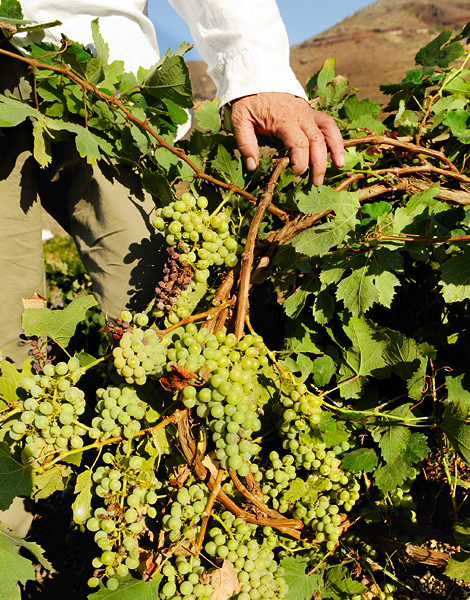
© Vaggelis Zavos
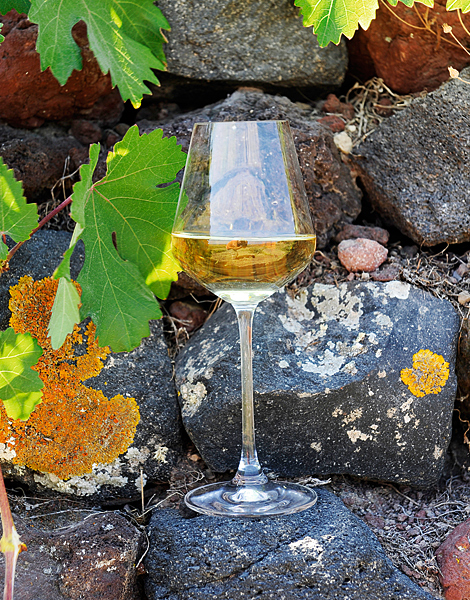
© Vaggelis Zavos
Assyrtiko: The Santorini cultivar
“There are more than 60 grape varieties on Santorini,” Abbe Pegues wrote in 1842, “but for the production of the ordinary wine and santo wine almost only one is used, the Assyrtiko, because it is the most prolific and the best.” Assyrtiko remains the dominant cultivar on the island, accounting for about 75 percent of the total terroir. It’s considered among the choicest white grape varieties in the entire viticultural “population,” because its important range of chemical composition allows the production of high-quality wines of various types (white fresh and high-grade aged, sweet and semi-sweet, sparkling and wines that mature under a film of saccharomycetes) depending on the degree of technological maturity at which the grapes will be harvested. It’s about a notable, multi-dynamic grape variety. But where did this blessed grape variety that has survived thanks to its resistance to powdery and downy mildew, two diseases of the vine that came from America and destroyed many European vineyards more than a century ago originate? Who brought the first cuttings of this plant, which has adapted so well to this difficult ecological environment and produces such high-quality wines with a special and distinctive character in terms of taste and aroma? No source has given an answer to these questions. However critical these questions are for historians dealing with the vegetal colonization and the routes followed by Dionysus’ sacred plant, one thing is certain: Assyrtiko has been enlivening the island’s volcanic earth with its greenery for hundreds of years continuously. Thanks to Assyrtiko, the most remarkable white grape variety in the whole of the Mediterranean basin, the Santorinians down the centuries have remained on their isle.
* Santorini: An Historical Wineland was published in 2015 by Foinikas Publications.
Assyrtiko has been enlivening the island’s volcanic earth with its greenery for hundreds of years continuously.

